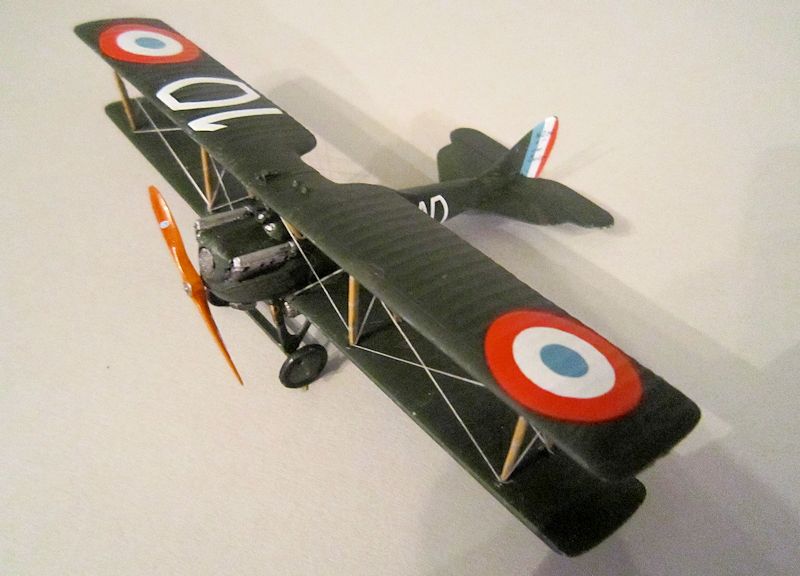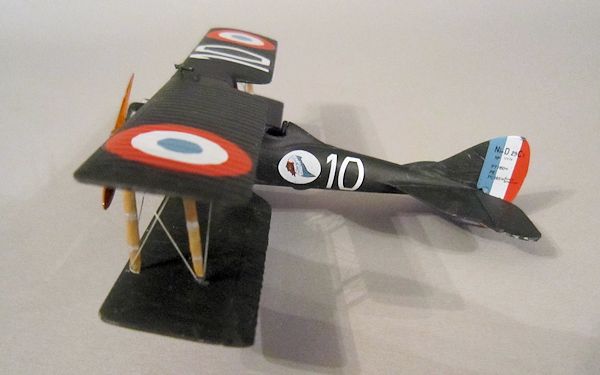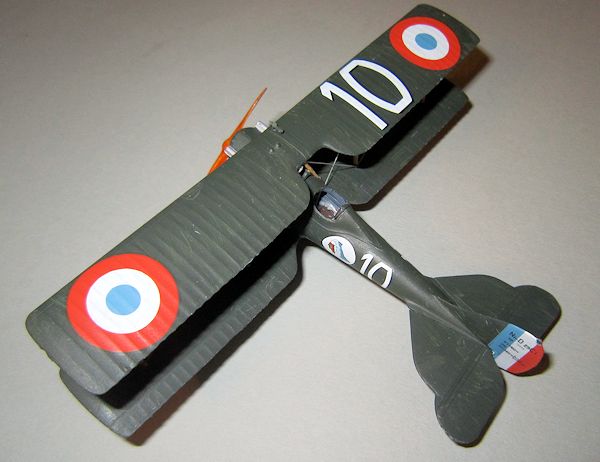
Azur /Frrom 1/72 Nieuport-Delage NiD.29
| KIT #: | FR008 |
| PRICE: |
£18
here in the UK, about $30 in the US. |
| DECALS: | Three options |
| REVIEWER: | Chris Peachment |
| NOTES: |
A
short run kit, and as far as I know the only injection one available of
this important type. There is an old Esoteric vacuform one, which crops
up on ebay, but I would not approach it without crucifix and garlic to
hand. |

| HISTORY |
The Ni-D 29 was a biplane with a nose-mounted Hispano-Suiza 8 engine and
a single open cockpit. The prototype first flew on the 21 August 1918, and
performed well but did not achieve the required ceiling. The second prototype
was modified with an increased wingspan and on achieving the required ceiling it
was ordered into production in 1920, becoming the fastest service fighter in the
world at that time.
 The
first deliveries were made in 1922 to the French Air Force and the type was
popular with pilots although it had a tendency to enter a flat spin. The French
military bought 250 aircraft. The Ni-D 29 was to become an important fighter in
the 1920s, with 30 bought by Spain (including 10 Spanish licence built
aircraft), and 108 by Belgium. The Italian
Regia Aeronautica
bought 175 aircraft including 95 built by Macchi as the
Macchi-Nieuport 29
and 80 built by Caproni. Sweden bought nine aircraft and designated them
J 2.
The
first deliveries were made in 1922 to the French Air Force and the type was
popular with pilots although it had a tendency to enter a flat spin. The French
military bought 250 aircraft. The Ni-D 29 was to become an important fighter in
the 1920s, with 30 bought by Spain (including 10 Spanish licence built
aircraft), and 108 by Belgium. The Italian
Regia Aeronautica
bought 175 aircraft including 95 built by Macchi as the
Macchi-Nieuport 29
and 80 built by Caproni. Sweden bought nine aircraft and designated them
J 2.
Nakajima bought one as a pattern and built 608, presumably by reverse
engineering,
for the Imperial Japanese Army, designated the
Ko-4. Interestingly
this made made Japan the largest user of the type.
Azur also does a number of variations in boxing,
including a silver version in Japanese markings.
Racing versions of the aircraft were also developed and they gained
eight world speed records and won the 1919
Coupe Deutsche de la Meurthe
and the 1920 races.
Three Ni-D 29s were modified using bomb racks with six 10 kg bombs, by
Captain Sadi-Lecointe in November 1925 and used on 70 sorties against insurgents
in Morocco. Spanish aircraft were also involved in similar operations in North
Africa.
 It is a
strikingly dainty aircraft, in spite of its double bays struts, and it has an
air of exquisite delicacy about it, especially in the way that the
fuselage narrows down at the rear, and the continuous
swoop from headrest to fin. The nose is streamlined probably because the
radiators are of the Lamblin lobster pot variety mounted between the
undercarriage struts, which don't detract from the lines in the way that they
can do on other aircraft. It looks like a winner, which is what it was, and it
looks forward to the great Nieuport racers of the 1920s.
It is a
strikingly dainty aircraft, in spite of its double bays struts, and it has an
air of exquisite delicacy about it, especially in the way that the
fuselage narrows down at the rear, and the continuous
swoop from headrest to fin. The nose is streamlined probably because the
radiators are of the Lamblin lobster pot variety mounted between the
undercarriage struts, which don't detract from the lines in the way that they
can do on other aircraft. It looks like a winner, which is what it was, and it
looks forward to the great Nieuport racers of the 1920s.
Here is a link to the preview done a couple of years earlier so you can see what comes in the kit.
| THE KIT |
 Azur are
building a good reputation for excellent short run kits, especially of French
and Italian designs. They aren't always cheap, and the Farman four engined
bomber that I would dearly like to build is an wallet-tightening £50 over here,
but they are the best game in town for some of the more obscure inter-war
aircraft, an area which is very under represented in kit form.
Azur are
building a good reputation for excellent short run kits, especially of French
and Italian designs. They aren't always cheap, and the Farman four engined
bomber that I would dearly like to build is an wallet-tightening £50 over here,
but they are the best game in town for some of the more obscure inter-war
aircraft, an area which is very under represented in kit form.
The plastic is moulded in grey and is easy to work. Some of the etch and resin parts are tiny, especially the very short exhaust tubes in resin, which I could not get to stay in line, and so have left off until I can find some plastic rod of tiny diameter. The Lamblin radiators are a little large and interfere with the fitting of the undercarriage. More of that later.
| CONSTRUCTION |
The basic
construction follows the usual pattern.
I kitted out the cockpit with some extra stringer
detail, which I usually regret as time wasted because it is invisible. This case
was no exception. All that is necessary is to paint the inner walls a suitable
primer colour. I chose a dark brown, reasoning that the exterior dark green
would result in something like that. And paint the seat aluminium., with a
leather cushion. The rest could easily be omitted.
 I
followed my usual practice with biplanes of building and painting fuselage and
wings separately. There is nothing complicated about the paint scheme, but it
always makes life easier for rigging. There were no fit problems with the
fuselage sides, and a quick swipe with a sanding stick was all that was
necessary, with no filler needed.
I
followed my usual practice with biplanes of building and painting fuselage and
wings separately. There is nothing complicated about the paint scheme, but it
always makes life easier for rigging. There were no fit problems with the
fuselage sides, and a quick swipe with a sanding stick was all that was
necessary, with no filler needed.
The struts
are best treated as small models in their own right, painted a light brown, with
a clear orange topcoat, and the small propeller can be done at the same time in
the same scheme. You then have to paint the silver “bandages”, three for each
strut. I messed around for a long time with equidistant markings on a small
piece of card as a template and very careful masking tape. But things got very
messy, and I had to start again, and just painted them on by eye with a very
fine brush. A steady hand is needed, but I find that as often as not, the naked
eye is as good at spotting problems of alignment as any constructed plan.
| COLORS & MARKINGS |
 The
wings and fuselage can then be given a couple of coats of dark green for which I
chose Life Color Italian Dark Olive Green FS 34052, which matches the box art.
The
wings and fuselage can then be given a couple of coats of dark green for which I
chose Life Color Italian Dark Olive Green FS 34052, which matches the box art.
At his
point the markings can be added. I chose the French squadron with the small
Native American head on it, which has very nicely detailed feathered bonnet.
Azur also offer a very nice alternative with a white racing greyhound. French
unit markings were always the most beautiful of any Air Force. There is also a
Belgian version with a thistle if you fancy that. All the decals were excellent
and sat down well with only a little Micro Sol needed on the rudder tricolour to
make sure each side went all the way over the edges.
| FINAL CONSTRUCTION |
Once the
lower wings have been added and set, then the struts can be carefully positioned
in their locating holes. I find the best time to fit the upper wing is when the
struts are all but set, just in that final phase where they are sturdy but still
open to being pushed around a little.
Once the upper wing is in place, I supported it all
around with some paperback books nudged up against the wing. There was no
problem with strut length, something which can spoil your day.
The cabane
struts did prove tricky however. Each set of three comes moulded in one piece,
but once the rear two are glued down, the front struts fall a little short of
the upper wing. I found it best to separate the forward struts and put them in
place once the upper wing had set.
 A
couple of tricky evenings were then spent rigging the thing, with elastic thread
coloured silver with a gel pen, and held in place with gel superglue. There were
really no problems, but the fighter is so very small that it takes time to
manoeuvre it into the best position and then to get the thread in between the
struts. I find a pair of sprung tweezers invaluable for holding a length of
thread in place while it sets.
A
couple of tricky evenings were then spent rigging the thing, with elastic thread
coloured silver with a gel pen, and held in place with gel superglue. There were
really no problems, but the fighter is so very small that it takes time to
manoeuvre it into the best position and then to get the thread in between the
struts. I find a pair of sprung tweezers invaluable for holding a length of
thread in place while it sets.
The axles was then mounted underneath and the wheels painted and glued in place. The rim between tire and hub is not very clear and so I did my usual trick of running a fine black felt tip around the rim to delineate it, and the tire black can be run up against it, but not over.
Wheels in
place and dried, and it was time for some final touching up. Painting of the
small details was easy. The nose inlet was gunmetal, as were the two oil coolers
under the nose. The Lamblin radiators were also gunmetal with a little dark grey
dry brushing. I left the mounting plates in brass. The two small maker's decals
were added to the prop and the prop spinner plate was painted in silver. And the
final touch was the stall warning horn, mounted on the upper wing, with the
short trumpet to the fore and the large to the rear. I imagine it was very
necessary, for an aircraft with a tendency to enter a flat spin, which is every
pilot's nightmare.
| CONCLUSIONS |
And voila, there you have a delightful little fighter, which was a pleasure to build, a pleasure to look at, and I feel sure was a pleasure to fly. France caught the aviation bug very early on, and have a long and distinguished history of building excellent aircraft. The French also have an eye for beauty, and their aircraft tend to have great aesthetic appeal. This one is, as my Australian wife would say, cracking easy on the eye.
| REFERENCES |
pyperpote.tonsite.biz
Some very nice pictures which give a good idea of the shade of green.
aviafrance.com
belgian-wings.be
http://riseofflight.com/forum/viewtopic.php?f=49&t=31540
November 2013
Copyright ModelingMadness.com. All rights reserved. No reproduction in part or in whole without express permission from the editor.
If you would like your product reviewed fairly and fairly quickly, please contact the editor or see other details in the Note to Contributors.